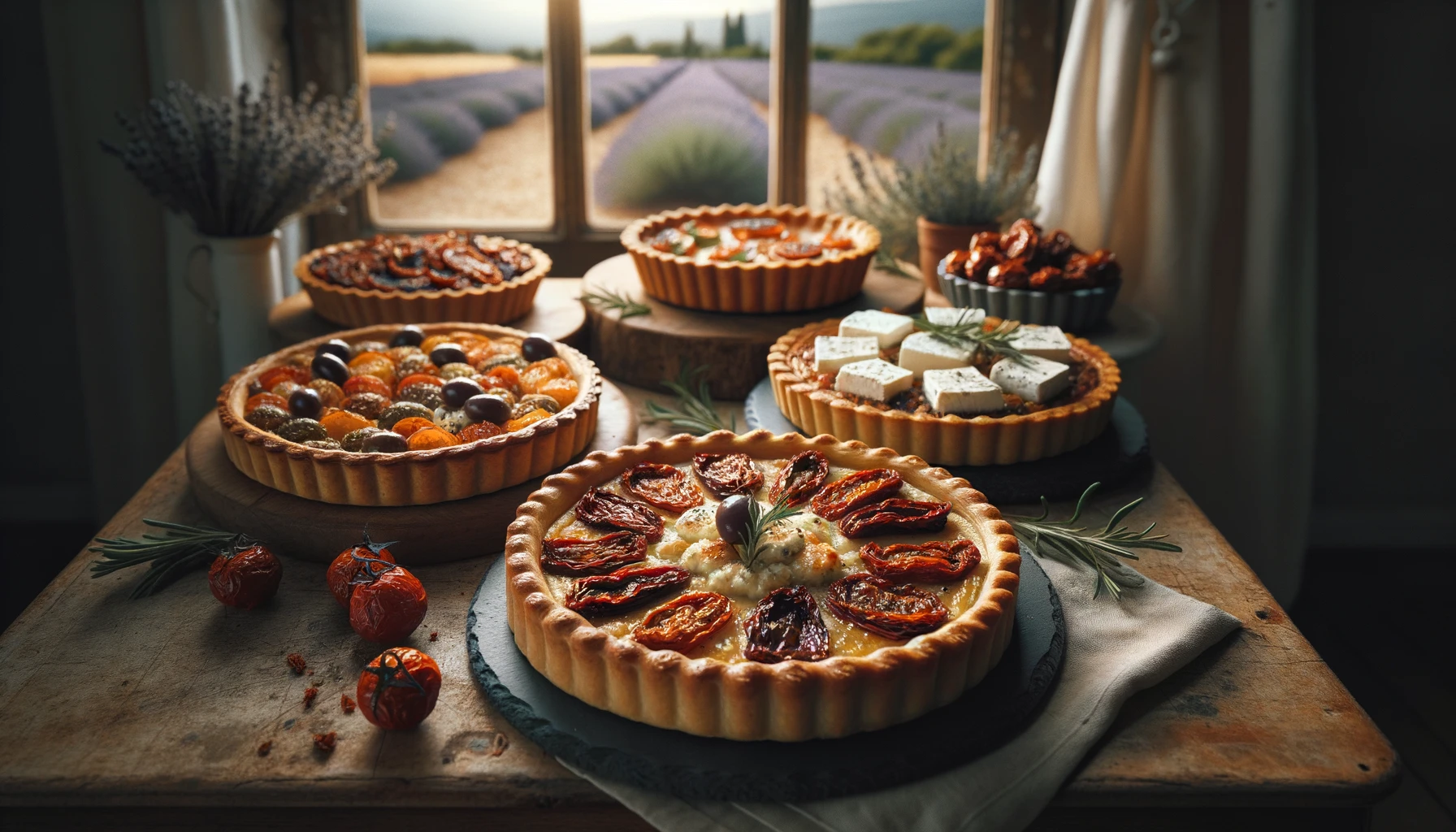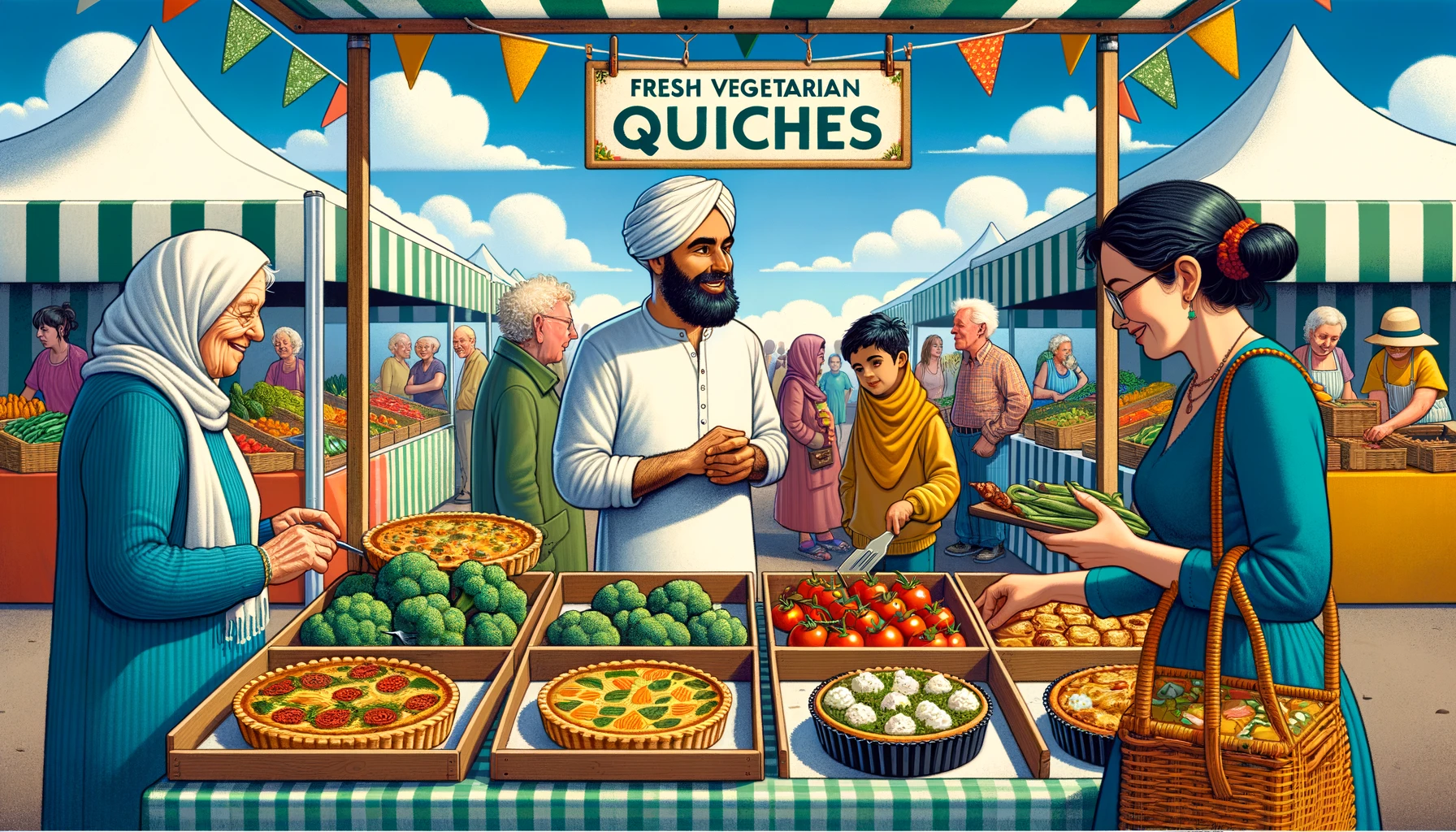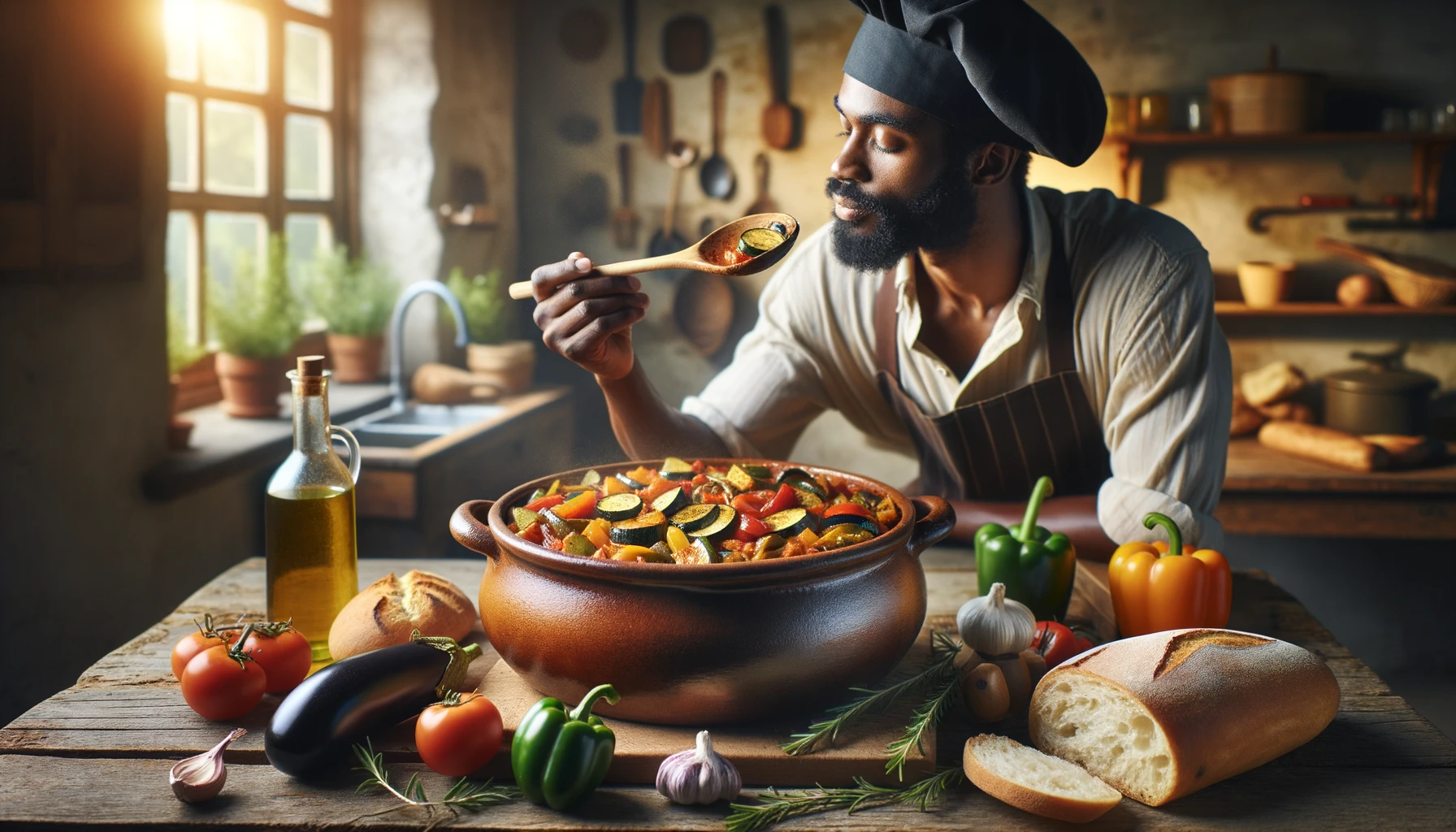French cuisine is renowned for its rich flavors and diverse dishes. However, it’s often associated with meat and dairy products, making it seem daunting for vegetarians. But fear not! There are plenty of protein-packed, naturally vegetarian French recipes out there, as well as creative modifications to classic dishes. Here, we present five must-try vegetarian French recipes that will make your taste buds dance with delight.
Savory Tarts: A Delightful Staple of French Cuisine
Savory tarts are a simple yet delicious staple of French cuisine. These versatile meals are generally topped with a variety of seasonal vegetables and a hefty layer of cheese, making them a delightful treat for any time of the year.

The Basics of Savory Tarts
Savory tarts are open to tons of possibilities, which leaves the window wide open for creative combinations. They can be made in any shape, size, and flavor, and the key to a perfect tart lies in its crust and filling. The crust can be a press-in crust, a roll-out crust, or a free-form crust, each offering a unique texture and taste.
The fillings for savory tarts can be as simple or as complex as you like. Some fillings may require advance preparation, while others can be thrown into a crust and baked directly. Baking times will vary based on the size of your tart pan or free-form creation, as well as the types of fillings inside. Generally, tarts around 9 inches in diameter will bake anywhere between 25 and 45 minutes.
Popular Savory Tart Varieties
There are countless varieties of savory tarts, each with its own unique flavor profile. Here are a few popular choices:
- Tomato Tart: Nothing beats a tomato tart during the summer months, especially when it’s topped with tangy cheeses, salty prosciutto, and a zippy gremolata.
- Cheese & Caramelized Onion Tart: This salty-savory number is complete with melty Gruyère cheese that takes it over the top.
- Leek, Fennel, and Mushroom Galette: Thanks to a runny egg yolk that the toppings and crust soak up, this tart doesn’t need a sauce or creamy drizzle.
- Fig & Blue Cheese Tart with Honey, Balsamic, and Rosemary: Blue cheese is just the right funky-tangy complement to all the earthy-sweet flavors in this tart, from the figs to the fresh rosemary.
The key to a perfect savory tart is to use high-quality cheese like gruyère, goat cheese, or roquefort.
Making Savory Tarts at Home
Making savory tarts at home can be a fun and rewarding experience. Here are some tips to ensure your tarts turn out perfect:
- Crust: Everything should be cold. The butter, milk, and eggs in these tarts should all be chilled beforehand and kept as cold as possible while making the pastry. This ensures that the butter doesn’t melt into the dough.
- Filling: Make sure to chill the filling before piping it into the shells. Chilling the cheese filling makes it a lot easier to pipe into the tart shells, allowing you to fill the tarts to their full capacity.
- Baking: Adjust the bake time to your preferred filling consistency. If you prefer the center of your cheese tart to be firmer, bake the tart for an additional 3 minutes, or until the tart doesn’t jiggle anymore.
Savory tarts are a delightful treat that can be enjoyed at any time of the year. Whether you prefer a classic cheese and caramelized onion tart or a unique fig and blue cheese tart, there’s a savory tart out there for everyone. So why not try making one at home? With the right ingredients and a little bit of patience, you can create a delicious savory tart that’s sure to impress.
Quiches: A Delicious Vegetarian Option

Quiches are a fantastic vegetarian option where the main protein source is eggs. These versatile dishes allow you to pick a cheese and a vegetable and create your own unique combinations. Some ideal pairings include:
- Spinach and goat cheese: a classic combination that brings together the earthy flavor of spinach with the tangy creaminess of goat cheese
- Leek and gruyère: The mild, onion-like flavor of leeks pairs wonderfully with the nutty, slightly sweet taste of gruyère cheese.
- Zucchini and parmesan: The tender, mild zucchini is complemented by the sharp, salty flavor of parmesan cheese.
- Onion and blue cheese: The sweetness of caramelized onions contrasts beautifully with the bold, tangy taste of blue cheese.
To make a delicious quiche, start by preparing a pie crust, either homemade or store-bought. Pre-bake the crust to ensure it’s cooked through and not soggy. Cook your chosen vegetables before adding them to the egg mixture, as this will help the quiche cook more evenly. Whisk together eggs, milk, and any desired seasonings, then add your cooked vegetables and cheese. Pour the mixture into the pre-baked pie crust and bake until the center is set and the edges are golden.
Remember to experiment with different combinations of vegetables and cheeses to create your own unique quiche flavors. Quiches are not only delicious but also packed with nutrients, making them perfect for a healthy vegetarian diet. So, why not try your hand at these vegetarian quiche recipes? Bon appétit!
Ratatouille: A Flavorful Vegetarian French Classic
Ratatouille is a delicious and versatile vegetarian dish that originates from the Provence region of France. It is a colorful and hearty stew made with a variety of summer vegetables, such as eggplant, zucchini, yellow squash, bell peppers, and tomatoes, cooked with garlic, onions, and fresh herbs. This dish is not only packed with nutrients but also offers a delightful combination of flavors and textures.

The Charm of Ratatouille
Ratatouille has gained popularity worldwide, thanks in part to the Disney movie of the same name. The dish is known for its versatility, as it can be served as a main course, a side dish, or even as a topping for pasta or rice. It can be enjoyed hot, at room temperature, or even cold, making it a perfect choice for various occasions and preferences.
Cooking Ratatouille
There are different ways to prepare ratatouille, but the most common method involves sautéing each vegetable separately in olive oil before combining them in a pot and simmering them together with crushed tomatoes and seasonings. This approach allows each vegetable to retain its unique flavor and texture while still melding together in the final dish.
An alternative method for making ratatouille is to roast the vegetables in the oven, which can result in a more caramelized and concentrated flavor. In this case, the vegetables are sliced and arranged in a baking dish, then drizzled with olive oil and seasoned with salt and pepper before being baked until tender.
Serving Suggestions
Ratatouille can be served in various ways, depending on your preferences and the occasion. Here are some ideas:
- As a main course, serve ratatouille over grains like rice, quinoa, or couscous, or with a side of crusty bread.
- As a side dish, pair ratatouille with simply prepared roasted or grilled meats, such as chicken, fish, beef, or pork.
- For a more filling meal, toss ratatouille with pasta or serve it shakshuka-style with poached eggs.
- As a topping for crostini, spread a layer of goat cheese on toasted bread and top with a spoonful of ratatouille.
Ratatouille is a delightful and nutritious vegetarian dish that showcases the best of summer vegetables. Its versatility and adaptability make it a great choice for various occasions and dietary preferences. So, why not give this classic French recipe a try and enjoy the vibrant flavors of ratatouille? Bon appétit!
Veggie Steak Tartare: A Vegetarian Twist on a Classic
Veggie steak tartare is a spectacular vegetarian take on the classic steak tartare. Traditionally, steak tartare is a meat-based dish made from raw, minced beef or horse meat. However, this innovative recipe replaces the meat with fresh, ripe tomatoes and red bell peppers, offering a creative and delicious way to enjoy a traditionally meat-based dish.

The Art of Veggie Steak Tartare
Creating a veggie steak tartare involves finely dicing tomatoes and red bell peppers to mimic the texture of minced meat. The vegetables are then seasoned with traditional steak tartare ingredients such as capers, mustard, and Worcestershire sauce, providing a burst of flavor that complements the freshness of the tomatoes and peppers.
The Appeal of Veggie Steak Tartare
Veggie steak tartare is not only a great option for vegetarians but also for anyone looking to incorporate more vegetables into their diet. It’s a light and refreshing dish that’s perfect for a summer appetizer or a healthy lunch. Plus, it’s a great conversation starter at dinner parties, thanks to its unique twist on a classic dish.
Serving Suggestions
Veggie steak tartare can be served in various ways:
- On Toast: Spread the veggie steak tartare on slices of toasted bread for a delicious and healthy appetizer.
- With Crackers: Serve it with your favorite crackers for a light and refreshing snack.
- In Lettuce Wraps: For a low-carb option, serve the veggie steak tartare in lettuce wraps.
- As a Salad: Toss the veggie steak tartare with mixed greens for a flavorful and nutritious salad.
Veggie steak tartare is a creative and delicious way to enjoy a traditionally meat-based dish. It’s a testament to the versatility of vegetables and the endless possibilities of vegetarian cooking. So, why not give this innovative recipe a try and experience the delightful flavors of veggie steak tartare? Bon appétit!
Cheese Soufflé
The cheese soufflé is a culinary masterpiece that truly tests a home cook’s abilities. Based on the iconic recipe by Julia Child, this dish is a showstopper that you might want to practice before a big dinner party. It’s a fluffy, cheesy delight that will impress your guests.

The Art of the Soufflé
The soufflé is an art form in the culinary world. It’s a dish that’s as unique as a Picasso painting, with each one being a one-of-a-kind creation. This billowy masterpiece, a hallmark of French culinary tradition, can be served as a sweet dessert or a savory meal.
The History of the Soufflé
The soufflé has been around for quite a while, and we have France to thank for this decadent treat. The real magic of a soufflé lies in its light and fluffy texture, something that recipe developers and chefs around the world love about this dish.
The Recipe
The recipe for a classic cheese soufflé involves a few key ingredients and steps. Here’s a brief overview:
Ingredients:
- 2 tablespoons finely grated parmesan cheese
- 1 cup milk, whole
- 2 1/2 tablespoons unsalted butter
- 3 tablespoons all-purpose flour, unbleached
- 1/2 teaspoon paprika
- 1⁄2 teaspoon salt
- 1 pinch ground nutmeg
- 4 large egg yolks
- 5 large egg whites
- 1 cup gruyere cheese, packed coarsely (about 4 ounces)
Steps:
- Position the rack in the lower third of the oven and preheat to 400 degrees.
- Butter a 6-cup (1-1/2 quart) souffle dish.
- Add Parmesan cheese and tilt the dish, coating the bottom and sides.
- Warm milk in a heavy, small saucepan over medium-low heat until steaming.
- Melt butter in a heavy, large saucepan over medium heat.
- Add flour and whisk until the mixture begins to foam and loses its raw taste, about 3 minutes.
- Pour in warm milk, whisking constantly until very thick, 2 to 3 minutes.
- Whisk in paprika, salt, and nutmeg.
- Add egg yolks one at a time, whisking to blend after each addition.
- Scrape the souffle base into a large bowl. Cool to lukewarm.
- Beat the egg whites in another large bowl until stiff but not dry.
- Fold 1/4 of the whites into a lukewarm or room-temperature souffle base to lighten.
- Fold in the remaining whites in two additions while gradually sprinkling in Gruyere cheese.
- Transfer the batter to the prepared dish.
- Place the dish in the oven and immediately reduce the oven temperature to 375 degrees.
- Bake until the soufflé is puffed and golden brown on top and the center moves only slightly when the dish is shaken gently, about 25 minutes.
- Serve immediately.
Tips for the Perfect Soufflé
- Get some air: The key to a perfect souffle is getting air into the mixture. To achieve this, beat the egg whites until stiff peaks form.
- Use the right souffle dish. The dish you use can make a big difference. A dish with straight sides will help the soufflé rise properly.
- Room-temperature eggs: Using room-temperature eggs will give you the best results.
- Use cream of tartar. Cream of tartar helps stabilize the egg whites, ensuring your soufflé rises properly.
- Serve immediately. Soufflés are best served fresh out of the oven. They do deflate quickly, but they can be stored in the fridge and reheated.
The cheese soufflé is a dish that requires precision and patience, but the end result is a fluffy, cheesy delight that is sure to impress. Whether you’re a seasoned home cook or a beginner in the kitchen, this recipe is a fun challenge to take on.
These recipes are not only delicious but also packed with nutrients, making them perfect for a healthy vegetarian diet. So, why not try your hand at these vegetarian French recipes? Bon appétit!
Remember, the secret to great French cooking lies in the techniques. From flambéing to sautéing, mastering these procedures will equip you with the skills to create delicious, mouthwatering dishes. So, don’t be afraid to experiment and make these recipes your own. After all, the joy of cooking lies in the journey as much as the destination.

